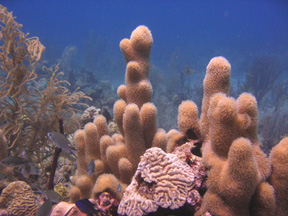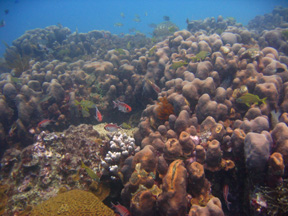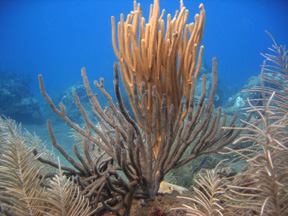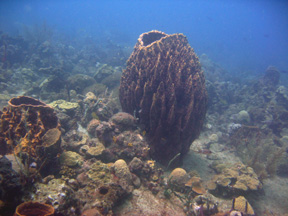|
Fringing Reefs (deep) |
|
|
The largest and best developed representative of this reef type (approximately 2.6 km long) is found along the west and southwest-facing contour of the shelf lining the Grand Savane area. It is architecturally diverse, with a high species richness and extensive live benthic cover of sponges, soft corals and hard corals. Local dive sites within this reef system include Lauro Reef, Rena's Reef and several other sites in between these two. The reef flat and the fore reef are the most appealing visually and in their diversity. Erosional sand chutes exist, these are often lined with massive framework builders such as M. annularis and M. faveolata. Intermittently, towards shore, the reef flat gradually transitions into sandy environments characterized by a variety of primary hard substrates originating from cliffs, beaches, and rivers, all of which form the stable substrate for sessile organisms. See "OTHER CORAL HABITATS". The northern-most section of this system, within approximately 500 and 150 m from the mouth of the Batali River, is characterized by a series of linear reefs, oriented perpendicularly to shore, in waters between 10 and 30 meters depth. Although not connected these individual reefs are aligned like a spur and grove system. Mero harbors the second largest such system along the West coast but with a substantial contribution of primary hard substrates in 5-10 meters depth. This region is also characterized by mixed sea grass beds and large (500 m2 +) mono-specific coral assemblages. See OLIGOSPECIFIC ASSEMBLAGES . Besides
these two locations, true fringing reefs in deeper waters (with
coral accretion) are virtually absent along the west coast. |
|
  |
  |
|
The top row depicts reef flat scenarios (left: pillar coral D. cylindrus, right: brain coral M. meandrites), while the bottom row shows typical fore reef scenario (le. star coral M. annularis, barrel sponge X. muta). |
|
INDEX | INTRODUCTION |REGIONS | HABITATS | SPECIES | STATUS | CONTRIBUTORS | REPORTS
Institute
for Tropical Marine Ecology ITME Inc., P.O. Box
36, Roseau, Commonwealth of Dominica.
ITME
is a not-for-profit institution for environmental education and research.